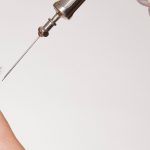Non – Surgical Rhinoplasty Using Filler:
Nonsurgical aesthetic treatments are usually preferred by patients because their effects are visible immediately after the treatment and patients can return to their normal activities on the same day.
Procedure of Nose Remodelling by Filler Injection:
Before proceeding with the treatment it is necessary to observe very deeply the relationship between the nose and the glabella, lips and chin. Corrections of the nose may require also the remodeling of the lips or the chin for a better harmony of the whole face. The patient should be in a semi-sitting position with the head reclined on the back of the operating bed, in hyperextension (110-120°), in order to have a comfortable working posture. Regional anaesthesia is very seldom required, though a topical anaesthesia will be useful if we inject near the tip of the nose.
How does it work?
Nonsurgical rhinoplasty uses dermal filler ingredients to change the shape of your nose.A gel-like injectable ingredient (usually hyaluronic acid) is inserted underneath your skin in the areas where you wish to create smoother lines or volume. SometimesTrusted Source Botox is also used.The filler ingredient settles into where it’s injected in your deeper skin layers and holds its shape. This can change the look of your nose for anywhere from 4 months to 3 years, depending on your skin, your desired results, and the ingredient used.
How Long Do Nose Fillers Last?
A non-surgical rhinoplasty is a great options for many of our patients. This is because the outcome is temporary, less expensive, and much less invasive than a rhinoplasty. Nose filler is not a ‘one-size-fits-all’ treatment since everyone has a different nose and different results that are seeking. Our goal is to give each patient the best, most natural-looking results possible. This means that for some patients, the best way to achieve their desired outcome is with surgery. It’s best to come in for a consultation to determine which option, if any, is right for you.
The filler is used to sculpt the nose by adding volume to the bridge, nasal tip or to even-out irregularities. If someone is wanting a much smaller nose or has an extreme bump, surgery is most likely a better option for them.
We usually recommend 2-3 touch-up appointments until optimal results are achieved and the patient is happy. We add the filler to the nose slowly since it is much easier to add filler than to take it away. Once the patient reaches their desired look, the filler last approximately 6-9 months. Over time, the body metabolizes the hyaluronic acid naturally. Since our bodies metabolize the filler, most patients come in every 6-12 months for touch ups to keep their non-surgical rhinoplasty looking its best. Liquid rhinoplasties provide instant results and are very easy to tolerate. It is important to see an experienced injector as serious vascular complications are possible.
What can you not do after nose fillers?
Avoid topical products such as Tretinoin (Retin-A), Retinol, Retinoids, Glycolic Acid, or any “anti-aging” products. Avoid waxing, bleaching, tweezing, or using hair removal cream on the area to be treated.
How do you sleep after nose fillers?
Make sure to sleep on your back with your head elevated using 2 pillows for 3 nights-this will ensure that the newly injected filler stays in place. Another option would be to use a wrap around neck pillow to stabilize your head.
Who people should be avoiding for doing this procedure?
Included patients who were pregnant; breastfeeding; with any preexisting condition that might affect patient safety, including active inflammation, infection, cancerous or precancerous lesions, and so on; with a known hypersensitivity to lidocaine, HA, and/or gram-positive bacteria proteins; with a history of connective tissue disease or bleeding disorders; who used aspirin and/or concomitant antithrombotic therapy during the week preceding the treatment.
Risks and side effects:
For most people, the only side effect of liquid rhinoplasty they’ll see is a little redness and sensitivity in the area of the injection in the day or two after the procedure.Other possible side effects include:
- bruising at the site of the injection
- swelling
- filler migration, meaning the injectable ingredient migrates to other areas of your nose or the area under your eyes, creating a “wavy” or “overfilled” look
- nausea
- The nose is a sensitive area. It’s filled with blood vessels and close to your eyes. That’s why liquid rhinoplasty is somewhat more complicated than other kinds of injectable filler procedures.
